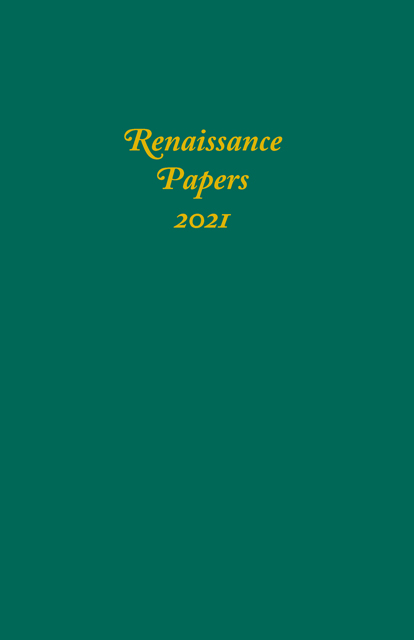Book contents
- Frontmatter
- Contents
- Dedication
- “Strange Serious Wantoning”: Early Modern Chess Manuals and the Ethics of Virtuous Subterfuge
- “Both Use and Art”: Motifs and Method in Astrophil and Stella
- Embodied Love(rs): Injury and Comedy in Mary Wroth’s Urania
- Edmund Spenser’s Automaton Alchemy: The Case of False Florimell
- Who Edited the 1571 Mirror for Magistrates?
- Statues Living and Conscious: Hermetic Statue-Magic in The Winter’s Tale
- Transmutation and Refinement: The Metaphysics of Conversion and Alchemy in Renaissance Spain
- The Twelve Inka and the Twelve Caesars: Reflections on an Early Modern Visual Theme in the Art of Colonial Peru
- Linguistics and Epistemology in Thomas Harriot’s North Atlantic World
- Assembling the King’s Body: Examining Holbein’s Portrait Techniques and the Fashioning of Henry VIII’s Image in the English Renaissance
- Molière’s L’École des Femmes between Shame and Guilt
Edmund Spenser’s Automaton Alchemy: The Case of False Florimell
Published online by Cambridge University Press: 17 December 2022
- Frontmatter
- Contents
- Dedication
- “Strange Serious Wantoning”: Early Modern Chess Manuals and the Ethics of Virtuous Subterfuge
- “Both Use and Art”: Motifs and Method in Astrophil and Stella
- Embodied Love(rs): Injury and Comedy in Mary Wroth’s Urania
- Edmund Spenser’s Automaton Alchemy: The Case of False Florimell
- Who Edited the 1571 Mirror for Magistrates?
- Statues Living and Conscious: Hermetic Statue-Magic in The Winter’s Tale
- Transmutation and Refinement: The Metaphysics of Conversion and Alchemy in Renaissance Spain
- The Twelve Inka and the Twelve Caesars: Reflections on an Early Modern Visual Theme in the Art of Colonial Peru
- Linguistics and Epistemology in Thomas Harriot’s North Atlantic World
- Assembling the King’s Body: Examining Holbein’s Portrait Techniques and the Fashioning of Henry VIII’s Image in the English Renaissance
- Molière’s L’École des Femmes between Shame and Guilt
Summary
Since C. S. Lewis’s comment that Edmund Spenser had a detailed knowledge of both “low” and “high” magic, Renaissance scholars have labored to unearth shards of concepts and images drawn from the world of Renaissance magic in the great Elizabethan poet’s oeuvre. However, these scholarly trajectories have either dissolved into obscurity or have been met with skepticism on the part of many Spenser scholars. These efforts have largely been frustrated by two critical obstacles. The first is a lack of detailed analysis of the presence of magical concepts and images in Spenser’s text. The second is the seeming contradiction between Spenser as the great “Protestant” or “Neo-Platonic Protestant” poet and Spenser as a “poet magus” steeped in the language and ideas of Renaissance magic. These two impediments have caused some confusion in the reading of key figures in Spenser’s Faerie Queene such as Merlin, Florimell (and False Florimell), Archimago, and even the critical consensus on Spenser’s own identity as a poet. However, a detailed analysis of the various schools of magic in the Renaissance reveals that a case could be made for even the use of ceremonial or “demonic” magic (as long as it was called “angel magic”) by Christians. One of these Renaissance Christians is Edmund Spenser who, in his Faerie Queene, utilizes natural and demonic magic as well as a myth common in the tradition of what Brian Copenhaver has called “Western magic,” that is, the notion that statues and other objects could become animated by the power of a spirit summoned by a magus, in his composition of False Florimell.
False Florimell, Animated Statues, and Demonic Magic
Within The Faerie Queene, a major figure who is composed of magically animated objects is False Florimell. False Florimell is crafted by the witch in Book III as a substitute for Florimell, a representative of ideal beauty pursued by a host of characters, including the magician Proteus, but finally married to Marinell, grandson of the sea god Nereus. Critics have, without fail, almost entirely focused upon False Florimell through the lens of Platonic metaphysics and aesthetics as well as Platonic notions of love. In his classic book The Kindly Flame, Thomas Roche writes that False Florimell’s beauty is only physical and has the power to inspire only lust.”
- Type
- Chapter
- Information
- Renaissance Papers 2021 , pp. 37 - 50Publisher: Boydell & BrewerPrint publication year: 2022



